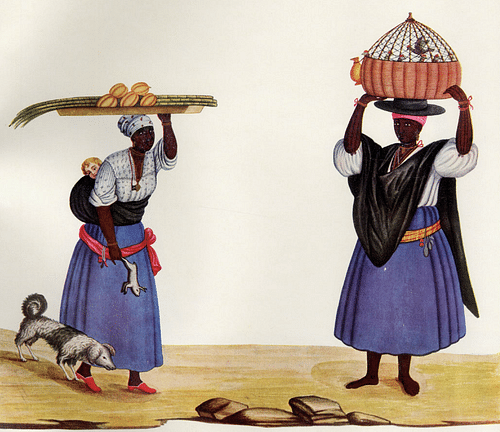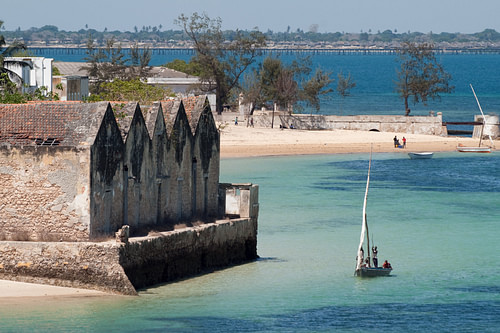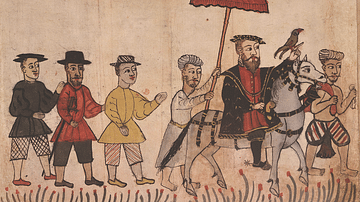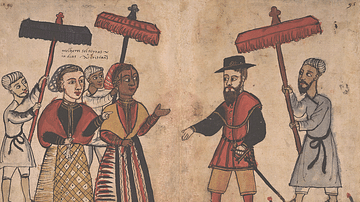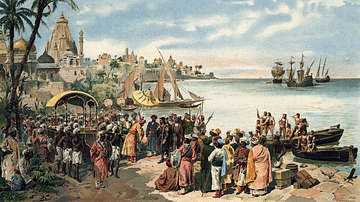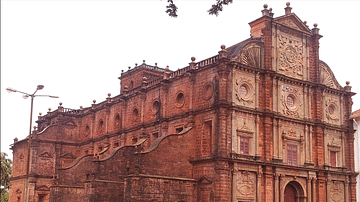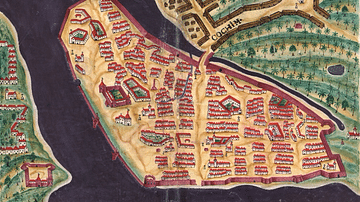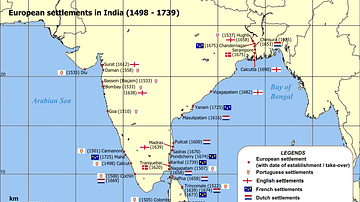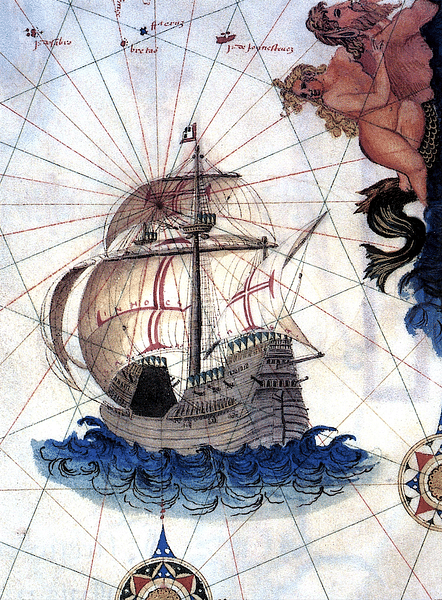
The Portuguese Empire was established from the 15th century and eventually stretched from the Americas to Japan. Very often a string of coastal trading centres with defensive fortifications, there were larger territorial colonies like Brazil, Angola, and Mozambique. White Europeans dominated trade, politics, and society, but there was also a significant mixing of races, and in many places, people of mixed ancestry rose to positions of wealth and power in the colonies.
The Portuguese began their empire as a search for access to the gold of West Africa and then the eastern spice trade. In addition, it was hoped that there might well be Christian states in Asia that could become useful allies in Christianity’s ongoing battles with the Islamic caliphates. New lands for agriculture, riches and glory for colonial adventurers, and the ambitions of missionary work were other motivations in the building of an empire.
Carrack ships created a maritime network that connected Lisbon with all of its colonies in the west and the Estado da India (‘State of India’) in the east, as the empire was known east of the Cape of Good Hope. Goods like gold, ivory, silk, Ming porcelain, and spices were carried and traded around the world. Another major trade was in slaves, taken from West and southern Africa and used as labour on plantations in the North Atlantic islands and the Americas.
The Key Colonies
The most important colonies in the Portuguese Empire were:
- Madeira (founded 1420)
- Azores (1439)
- Cape Verde (1462)
- São Tomé and Principe (1486)
- Portuguese Cochin (1503)
- Portuguese Mozambique (1506)
- Portuguese Goa (1510)
- Portuguese Malacca (1511)
- Portuguese Hormuz (1515)
- Portuguese Colombo (1518)
- Portuguese Brazil (1532)
- Portuguese Macao (c. 1557)
- Portuguese Nagasaki (c. 1571)
- Portuguese Angola (1571)
The North Atlantic Islands
The Portuguese were intrepid mariners and so it is entirely appropriate that their first colonies should be relatively remote islands. Searching for new resources and land which might solve Portugal’s deficit in wheat requirements, mariners sailed towards the unknown mid-Atlantic Ocean. The Portuguese navigators were able to mount these expeditions thanks to such rich and powerful backers as Prince Henry the Navigator (aka Infante Dom Henrique, 1394-1460). Another immeasurable advantage was innovative ship design and the use of the lateen triangular sail.
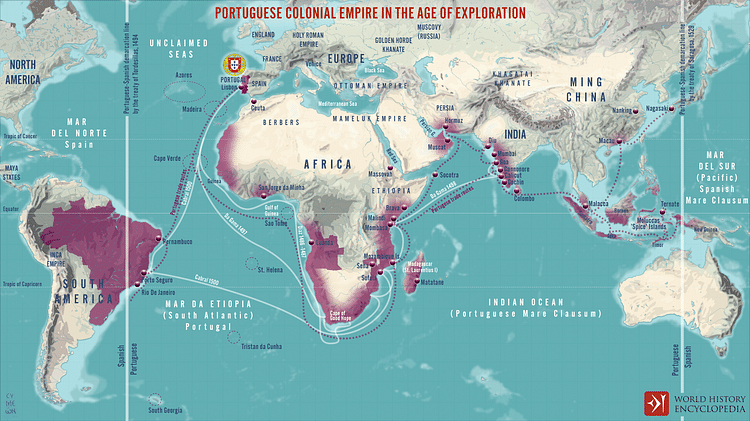
The first group of islands to be colonised was the volcanic and uninhabited Madeira archipelago. With rich volcanic soil, mild climate, and sufficient rainfall, the islands were used to grow wheat, vines, and sugar cane. In many ways, the Portuguese colonization of Madeira would set the template that all other colonies copied. The Portuguese Crown partitioned the islands and gave out ‘captaincies’ (donatarias) as part of a feudal system designed to encourage nobles to fund agricultural and trade development. The Crown retained overall ownership but each captain (donatario) was given certain financial and judicial privileges, and they, in turn, gave out smaller parcels of their land (semarias) for development by their followers who had to clear and begin cultivation within a certain number of years. These captaincies became hereditary offices in many cases. Settlers were attracted by the hope of a better life, but there were, as there would be in all future colonies, other, less desirable immigrants. These were the undesirables (degregados), people unwanted by the authorities in Portugal who were forcibly transported to colonies such as convicts, beggars, reformed prostitutes, orphans, Jews, and religious dissidents.
Another way in which Madeira became a colonial model was sugar cane plantations, created from 1455. The success of this crop and its large labour requirement led to slaves being imported from West Africa to work them. The slave-worked plantation system became an important part of the economy in the New World that led to the terrible traffic in humanity that was the Atlantic slave trade.
After Madeira, and following the same pattern, there followed the Portuguese colonization of the Azores and the Cape Verde group. These colonies all became invaluable ports of call for ships sailing from India and the Americas. The Portuguese were not without rivals for these colonies. Portugal and Spain squabbled over possession of the Canary Islands, but the 1479-80 Treaty of Alcáçovas-Toledo and the 1494 Treaty of Tordesillas set out two spheres of influence, audaciously, spheres which encompassed the globe. The vagueness of these agreements caused trouble later such as Portugal’s right to future discoveries in Africa and Spain’s to islands beyond the Canaries, interests which were eventually identified as the Caribbean and even the Americas.
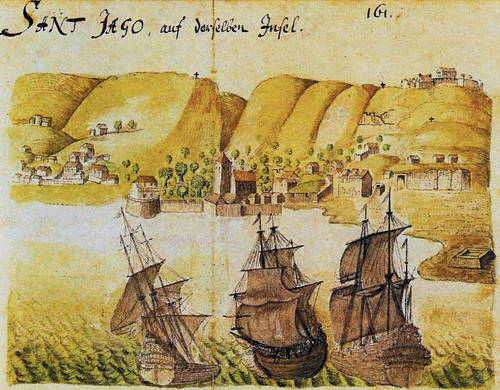
The North Atlantic islands permitted the Portuguese Crown to gain direct access to the gold of West Africa, avoiding the Islamic states in North Africa. A significant obstacle had been Cape Bojador which seemed to block sailing ships from going south and then returning home to Europe. The Atlantic islands and setting a bold course out away from the African coastline to best use winds, currents, and high-pressure areas provided the solution. Portuguese mariners could now sail south with confidence, and the ultimate result was the opening up of Asia to European ships.
West Africa & Slavery
The Portuguese, keen to access the West African gold and salt trade, set up several fortified trading settlements along the southern coast (modern Ghana) such as at Elmina in 1482. However, tropical diseases, a lack of manpower, and a reluctance by local rulers to allow male slaves to be exported meant that, at least initially, the profits were limited here. African chiefs were keen to trade for firearms, but these the Portuguese would not release. A more successful strategy focussed on the uninhabited islands of São Tomé and Principe, located off the southern coast of West Africa, which were colonised from 1486. The two islands became heavily involved in the slave trade, and, as in the North Atlantic, the captaincy model for development was used.
Settlers on the islands were permitted to trade with communities in West Africa, and they proved more successful than the attempts made a few decades before. Portuguese trade settlements were established on the continent as far south as Luanda (in modern Angola) to take advantage of the well-organised African trade that saw goods travel from the interior along the major rivers (e.g. Gambia and Senegal) to the coast. Goods acquired included gold, ivory, pepper, beeswax, gum, and dyewoods. Slaves (men and women) were acquired from the Kingdom of Kongo and Kingdom of Benin, the rulers of which were eager for European trade goods like cotton cloth, mirrors, knives, and glass beads. The islands acted as a gathering point for slaves and as a place to take onboard provisions for the ships which would carry the human cargo. One in five slaves died on these ships, but as many as one in two slaves died between initial capture and arrival at their final destination. The Atlantic slave trade ended in the mid-19th century, but even after that, slaves continued to be imported to São Tomé and Principe until prohibition in 1908. Slaves were then replaced by African labourers who had to be repatriated after a certain number of years, but their living conditions were little different from those their slave predecessors had suffered.

There was little attempt at territorial conquest in West Africa as trade was thriving and the Europeans did not possess the military resources for such a policy. Some settlements were fortified, but this was usually done with permission from the local African tribal chief. Europeans and resettled Africans had intermarried on islands such as the Cape Verde group, creating an Afro-Portuguese culture, which had a strong African religious and artistic influence. It was very often these free mixed-race Cape Verdeans (mulattoes) who settled in the trading posts on the coast of Africa.
There were moves to cut out African chiefs and directly acquire slaves from the interior, but this policy soured relations with Kongo. The situation further deteriorated following a reaction against Christian missionaries as traditional cultural activities and tribal loyalties broke down. The Europeans were obliged to move further down the coast to the Ndongo region, where their interference led to a series of wars in a region which would soon become Portuguese Angola.
East Africa
When in 1498 the explorer Vasco da Gama (c. 1469-1524) sailed around the Cape of Good Hope and into the Indian Ocean, suddenly the Portuguese gained access to a whole new trade network involving Africans, Indians, and Arabs. This had been going on for centuries, but when the Portuguese arrived commerce became violent. Using superior ships and cannons, the Portuguese blasted rival ships out of the water, crews were arrested or killed and their cargoes confiscated. The fact that most traders were Muslim was an added motivation for the Europeans who were still beset with a crusader mentality.
Portuguese attacks on the independent trading cities of the Swahili Coast and on the inland Kingdom of Mutapa in the south (Zimbabwe/Zambia) did not bring any tangible benefits as traders simply moved to the north or avoided them. When the Portuguese had taken over and fortified the likes of Malindi, Mombasa, Pemba, Sofala, and Kilwa, they found they had already lost the trading partners of these city-states. Then the Omani Arabs of the Persian Gulf arrived. Keen to keep hold of their Red Sea trade routes and re-establish the age-old trade networks, the Omani moved in on the Swahili Coast and captured many cities, including Portuguese Mombasa in 1698. The lack of success in East Africa eventually drove the Portuguese south to Mozambique, but they were already wholly distracted by the potential of a newly discovered area of the world: India.
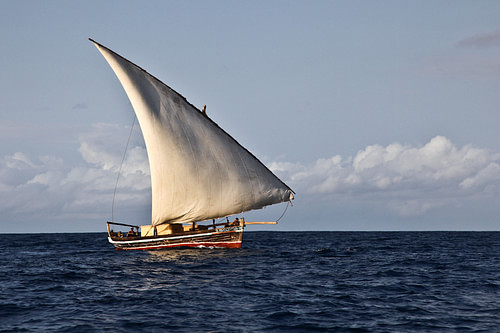
India & Spices
One of Vasco da Gama’s prime objectives was to find a maritime route to Asia so that Portugal could gain direct access to the lucrative spice trade. Spices like pepper, ginger, cloves, nutmeg, and cinnamon fetched high prices in markets from England to China. When he reached India’s Malabar Coast, the mariner did indeed find a wealth of trade going on. The city of Calicut (Kozhikode) proved unfriendly, but more Portuguese expeditions followed, and Calicut’s great rival Cochin (Kochi) looked more promising. A deal was struck with the local ruler, a fortress built in 1503, and the Portuguese settled in to do some big business. Unfortunately, they had a major problem: very few people were interested in any European goods. Consequently, they adopted the same strategy as they had on the Swahili Coast. Superior ships and cannons were used to take over the Indian Ocean trade network by force and establish a monopoly on the spice trade. Other coastal cities were taken over or established, notably Goa which replaced Cochin as the capital of the Estado da India in 1530.
It was at Goa that the Portuguese Viceroy of India resided, he was the top of a pyramid of power that was created with the primary goal of controlling commerce. The viceroy was the civil and military governor of Portuguese India and accountable only to the king of Portugal. In Lisbon, the conselho ultramarino advised the monarch on the affairs of the overseas colonies, while the Casa da India was the crown agency that supervised all communications and trade with Asia.
In Goa and most other colonies, there was a câmara, a council which decided on local issues like taxes. Religious affairs were led by an archbishop or bishop, and churches, monasteries, convents, and hospitals were established by all the major religious orders but particularly the Jesuit Society. Branches of the Misericórdia brotherhood offered essential social welfare services to the poor. Legal matters were the responsibility of a High Court in Goa and local courts in each colony. A captain led the local military force, which usually resided in a fort, and a factor was responsible for royal trade and extracting the lucrative customs duties from other types of trade. This was the colonial model applied in most colonies.
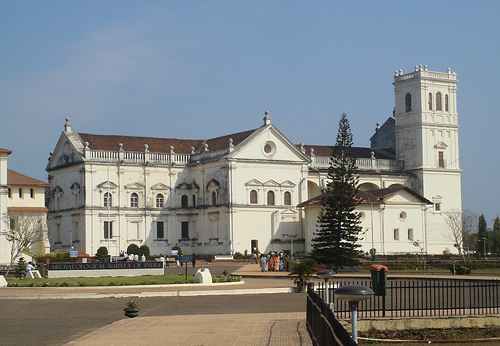
The Portuguese made a serious attempt at establishing a monopoly on the spice trade both between Asia and Europe and within Asia itself. The seas were no longer free. Traders without a license were arrested or executed and their goods confiscated. Certain ports were restricted, ships had to carry a Portuguese-issued passport (cartaz) and were often obliged to travel in Portuguese-protected convoys (cafilas). Customs duties were charged at ports, and these accounted for some 60% of the entire Portuguese revenue in the East. Nevertheless, many traders simply avoided the Europeans, some cities provided armed resistance, and the empire was simply too large and the manpower too little to police even a small part of the Asian-wide trade going on. These practical considerations did lead the Portuguese to relax their mania for trade monopolies as the empire matured.
The Far East
Another Portuguese strategy to control trade was to find the source of the precious spices. Many spices came from one small island group in Indonesia, the Spice Islands (the Maluku Islands or the Moluccas). Most of the spices from these islands were shipped to Malacca (Melaka) on the southwest coast of the Malay peninsula which controlled the Malay Straits leading from the Indian Ocean into the South China Sea. A Portuguese fleet led by Afonso de Albuquerque (1453-1515) took over Malacca in 1511, and sandalwood was acquired from their informal settlements on Timor from 1512.
The Portuguese were keen to access the lucrative Chinese silk market and so Portuguese Macao was established on a peninsula of the Pearl River delta in southern China near Guangzhou (Canton). Similarly, the colony of Portuguese Nagasaki on the northwest coast of Japan’s Kyushu Island was founded c. 1571, giving access to that nation’s trade goods, foremost of which was silver. Loaded with cargo for trade, Portuguese ships regularly sailed back and forth between Lisbon, Goa, Malacca, Macao, and Nagasaki, their most eastern colony. The Japanese government expelled all foreigners from the mainland in 1639 as part of a permanent policy of isolation and reaction against the spread of Christianity, and so Nagasaki had to be abandoned.
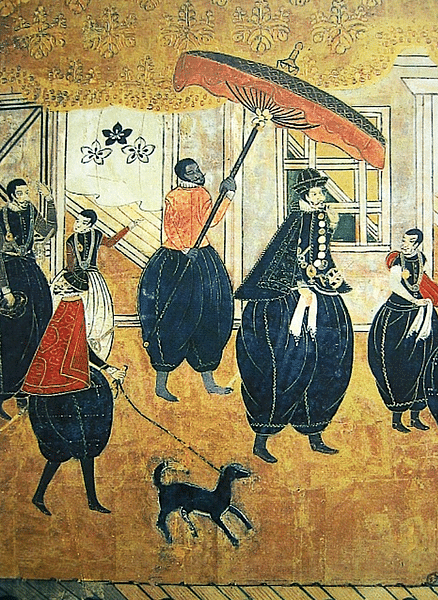
Brazil
Brazil was 'discovered' by the Portuguese in 1500, and it would become the most important of all their colonies. Brazil was rich in natural resources such as hardwoods, diamonds, and gold (from the Minas Gerais region). Captaincies were handed out, and São Vicente became the first Portuguese settlement in 1532. The first governor of Brazil was appointed in 1549, and Brazil was made an official Crown colony. The capital was established at Salvador da Bahia (replaced by Rio de Janeiro in 1763). A viceroy was appointed in 1572.
The colonial plantation model with Amerindian and then African slave workers was introduced on a much larger scale than anywhere else, and Brazil became the world’s leading producer of sugar and then tobacco. In the first quarter of the 17th century alone, 150,000 African slaves were brought across the Atlantic to South America. The abolition of the slave trade by an independent Brazil in 1853 finally put an end to the transatlantic trade.
Another casualty of colonization besides slaves was the Tupi-Guarani Amerindians whose villages and culture were systematically destroyed, forcing those that remained to flee far into the interior of the rainforest. It took until 1755 for the Amerindians to be recognised as full and free subjects of the Portuguese Crown.
In Brazil, colonial society was, as elsewhere, multilayered. The Europeans had the highest status, and social display was commonly achieved through extravagant clothing and the number of servants, slaves, and armed men they had. The Europeans divided themselves into three classes: Europeans, Europeans born in the colonies, and mixed-race Europeans (there were very few European women in any colony). On top of this were another four layers based on membership of the nobility, clergy, army, and all others (subdivided into the married and unmarried). There were also visiting Europeans such as maritime traders, and local merchants from the wider region. Then there was the local population, by far the majority in any colony, who might be divided by their own social ranks and by such factors as their conversion to Christianity. At the very bottom of colonial society were the slaves.
Southern Africa
The Angola region was colonised by the Portuguese from 1571, and it became the first European territorial colony in Africa (as opposed to a mere city-state or coastal settlement). The Kingdom of Ndongo (formed c. 1500) collapsed, but not before it had been exploited as an ally against Kongo to the north. The Europeans had the advantage of gunpowder weapons and so Portugal’s first territorial conquest had begun. It was an ominous prelude to what was to take place all over Africa in the coming centuries.
Once again, Portuguese settlers mixed with local peoples in the Angola region to create a mixed race known as Luso-Africans. The settlers and their descendants, based at Luanda and a few other coastal settlements, struggled to assert control over Angola’s interior where the new Kingdom of Matamba was on the rise. A century of fighting followed known as the Angolan Wars. The colony turned out to be a disappointment for Portugal. Much-talked-about silver mines in the interior proved to be only a legend, resources were limited, and hopes to spread Christianity proved overly ambitious. Some private settlers and traders prospered, and it was these who ensured the continuance of the colony’s main trade: slaves. By the late-16th century, nearly 10,000 slaves a year were being exported from Angola to be shipped directly from Luanda to Brazil and elsewhere in the Americas. Angolan communities, already reeling from smallpox and other diseases brought by the Europeans, were devastated by the trade.
On the other side of southern Africa, the Portuguese had created another large territorial colony: Mozambique (adopting the name of Portuguese East Africa in the 19th century). The first Portuguese settlers arrived on Mozambique Island from 1506 when a captaincy was created. Mozambique was not as gold-rich as hoped, but there was ivory and slaves. Mozambique became a part of the Estado da India from 1571 (but left in 1752), and carrack ships traded directly with Goa as part of the route known as the carreira da India. In the interior, a system developed known as prazo where African chiefs gave land and trade and tribute rights to Portuguese and Afro-Portuguese, an appointment then formally recognised by the Portuguese Crown. In return, the appointee (a muzungo) had to ensure justice was carried out in his territory, supervise traditional rituals, and approve chiefs of smaller villages in their jurisdiction. To maintain their position, muzungos had a private army of retainers (chicunda) which could number several thousand Africans. By 1637, there were at least 80 prazos, and most acted independently of the weak Portuguese administration at the capital Maputo.
The Portuguese Crown then left the colony to be exploited by private companies like the Mozambique Company and the Niassa Company. The lack of a central administration and the success of the British in southern Africa also put paid to the dream of connecting their two African colonies of Angola with Mozambique.
Decline, Decolonization & Legacy
Besides an often ever-present threat from local rulers, the Portuguese faced fierce competition from other European maritime powers who soon began to eye enviously their empire. This was especially so given the lack of upkeep of Portuguese forts and the general isolation of individual coastal cities, which had no supporting local population to come to their aid. English and French privateers loved nothing more than picking off Portuguese trade ships as they sailed the High Seas. Another major threat came, ironically, in the guise of a Portuguese explorer, one Ferdinand Magellan (c. 1480-1521), who, in the service of Spain in 1519-22, sailed around the southern tip of South America and pioneered a maritime route across the Pacific Ocean and on to East Asia. The expedition eventually circumnavigated the globe, but it was access to the spice trade that was crucial. Other European countries followed Magellan’s wake, and suddenly the Portuguese no longer had any hope at all of obtaining a trade monopoly in the East.
The most successful and widespread threat to Portuguese territories came from the Dutch who attacked Mozambique in the first decade of the 17th century, Macao in 1622 and 1626, and Angola in 1641. In the 1620s and 1630s, the Dutch attacked and occupied parts of northern Brazil. They captured Malacca in 1641, Colombo in 1656, and Cochin in 1663. Britain was another growing threat, and they helped the Arabs retake Hormuz in 1622.
In the 18th century, the Portuguese in Brazil were obliged to give very favourable trade rights to the superior maritime powers of Britain, France, and the Netherlands. The British even occupied Goa from 1799 to 1815. Other threats were internal. In Brazil, the people wanted equal rights for all citizens, and they achieved independence in 1822. They declared Pedro I (r. 1822-1831) as their king and the first Emperor of Brazil. Pedro was the son of João VI of Portugal (r. 1816-1826), and the two countries maintained close ties thereafter.
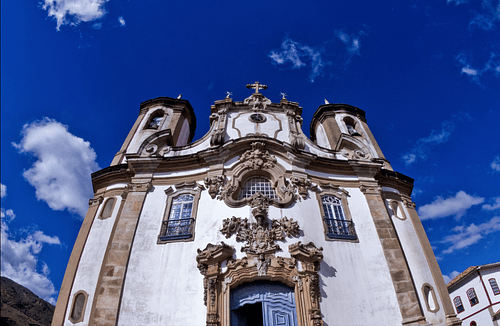
By the 20th century, many of the Portuguese colonies were lost to either rival powers or internal warfare. Of those which remained, Madeira and the Azores became autonomous regions of Portugal, and Goa became a part of India in 1962. The Portuguese government, then a military dictatorship under António de Oliveira Salazar (ruled 1932-1968), refused to see the futility of fighting African independence movements, and bloody wars followed in both Angola and Mozambique. The Cape Verde islands, São Tomé and Principe, East Timor, Angola, and Mozambique all gained independence from Portugal in 1975. Macao was returned to China in 1999.
The Portuguese colonial empire brought many disasters on indigenous peoples: slavery, warfare, disruption of trade networks, an end to traditional cultural activities, deforestation, and diseases, to name just a few. Other consequences included the continued prevalence of the Portuguese language and Catholic religion in many parts of the world today. The Portuguese were also directly responsible for spreading flora and fauna around the world, sometimes with disastrous effects on local ecosystems but also with notable successes as crops like manioc, maize, and sugar cane which became common in entirely new locations. Finally, the Portuguese had been the first to build a truly global empire across several continents, even if it had been a rather shaky and disjointed one. Their greatest legacy, perhaps then, is the unfortunate one that other European powers now realised the possibilities of imperialism and so set about exploiting peoples worldwide to an even greater degree when colonialism became a question of not merely control of trade but of territorial, resource, and population control.
